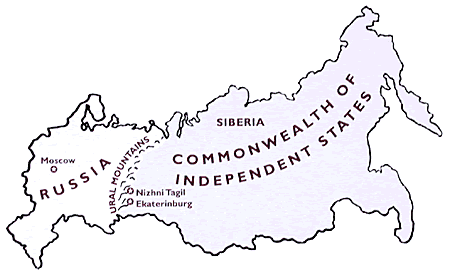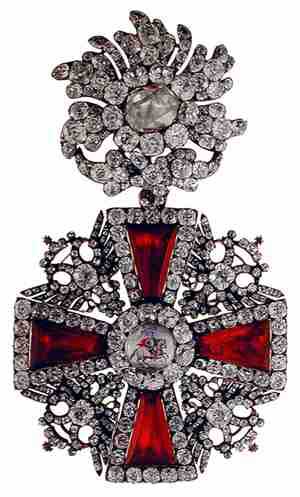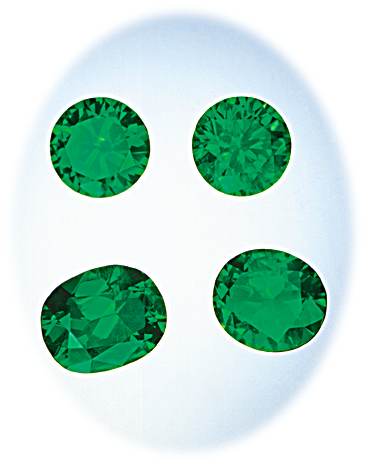|

The Gem Spectrum is Pala International’s
free newsletter. Edited by Pala’s own Gabrièl
Mattice, it is filled with interesting articles on various
aspects of gems and minerals.
We
distribute The Gem Spectrum free
within the United States to members
of the gem and jewelry trades. If
you would like to be added to our mailing
list, please contact us.


A brief history
Unearthed during
the reign of Alexander II, demantoid garnet
has a past as rich with history as the
privileged royalty whom it once adorned.
Discovered
in the mid to late 1800s, demantoid (meaning
diamond-like) is derived from the Dutch
word demant, meaning diamond. It
is mined in the Central Urals of Russia,
where it is found in alluvial gold washings
of the Sissersk District, Nizhni-Tagil;
and from the Bobrovka River. In its earlier
times, it was called “Bobrovka Garnet,” as
well.
Seeing
the small size of the crystals uncovered
at that time, there were those who said
that demantoid would never amount to
anything more than obscurity. This prediction
seemed even more prescient after the
Bolshevik Revolution in 1917, when the
Communists seized Ekaterinburg and the
city was renamed to Sverdlov (after the
Bolshevik, Yakov Sverdlov, who arranged
the execution of the Czar). Subsequently,
all fine jewelry and gems were viewed
as capitalist baubles and seized. However,
demantoid continued to enjoy a popularity
in the U.S. and Europe, partly due to
the fact that it had suddenly become
so difficult to acquire.
The
Bobravka River in the Ural Mountain region
has historically been considered the
premiere source of not only demantoid,
but also alexandrite. At present, extremely
fine demantoid is being brought out in
limited amounts, with commercial material
more readily available. The color ranges
from the more commonly found bright yellowish-greens
to a much rarer tsavorite-like intense
green. Ural demantoids are generally
smaller in size than those from the new
demantoid mines in Namibia, although
the color of the Russian material is
a richer, more vivid green.
Recent
developments in Russia have made it possible
for Pala International to acquire an
exquisite collection of fine-quality
demantoids.
 |
| Map of Russia, showing the location
of Ekaterinburg and Nizhni Tagil. |
|
Geography
 Many
people picture the Urals as a cold, barren wasteland but,
to the contrary, heavy industry and factories thrive there.
The 2,000-km (1,250-mile) long Ural mountain range reaches
1894 meters (6213 ft) at its highest point and marks the
divide between Europe and Asian Siberia. Russia lies west
and north of the Urals, with the Commonwealth of Independent
States (CIS) to the east and Kazakhstan to the south. During
World War II, Stalin moved 1,360 factories and thousands
of his people behind the Urals for protection from ground
troops and air attack. Since it produced 40% of all Soviet
military machinery, the area thrived. Many
people picture the Urals as a cold, barren wasteland but,
to the contrary, heavy industry and factories thrive there.
The 2,000-km (1,250-mile) long Ural mountain range reaches
1894 meters (6213 ft) at its highest point and marks the
divide between Europe and Asian Siberia. Russia lies west
and north of the Urals, with the Commonwealth of Independent
States (CIS) to the east and Kazakhstan to the south. During
World War II, Stalin moved 1,360 factories and thousands
of his people behind the Urals for protection from ground
troops and air attack. Since it produced 40% of all Soviet
military machinery, the area thrived.
In
the 19th century, Ekaterinburg became
the Urals’ most important urban
center. Named after Peter the Great’s
wife, Ekaterina, this city became widely
known as a center for Russian Imperial
Lapidary Works. Czar Nicholas II
commissioned only the finest skilled
artisans to create elaborate pieces that
he would bestow upon his beloved Czarina.
Ekaterinburg is most famous not only
for producing some of the Czar’s
most beautiful jewelry pieces but for
the role it played in his execution following
the Bolshevik Revolution.
Having
been warned of impending imprisonment,
it is said that the daughters and Czarina
sewed gems into the hems of their gowns
in the event that they were able to escape.
After seizing power and fearing sympathy
and support from the masses, the Communists
imprisoned Czar Nicholas II and his family.
In April, 1918, after moving them to
several locations, they were brought
to Ekaterinburg, where they were executed.
Gemology
 Demantoid
belongs to the andradite species – a calcium-iron garnet.
The stones range in color from pale green and yellowish green
(due to trace amounts of iron) to a fine emerald-green (due
to trace amounts of chromium). Its refractive index (1.875)
and dispersion (0.057 b to g) are both the highest of all
natural garnets. Because of the high dispersion, a faceted
stone will often show a fine play of prismatic colors. Demantoid
belongs to the andradite species – a calcium-iron garnet.
The stones range in color from pale green and yellowish green
(due to trace amounts of iron) to a fine emerald-green (due
to trace amounts of chromium). Its refractive index (1.875)
and dispersion (0.057 b to g) are both the highest of all
natural garnets. Because of the high dispersion, a faceted
stone will often show a fine play of prismatic colors.
Although
byssolite (the fibrous form of amphibole)
does form a comet-like inclusion commonly
known as a “horsetail,” past
analysis has determined that this inclusion
can also be chrysotile (the fibrous form
of serpentine). These horsetails appear
as fine silky strands connected at one
end by a common center and spray out
much like the end of a comet. Such fibers
can also be randomly dispersed, with
no apparent organization. They are an
important feature for identification
of demantoid.
Although
demantoid is softer than any other garnet
(6.5 on Mohs’ scale), however, it
wears very well in most jewelry. Its
specific gravity (SG) ranges from 3.84
to 3.85 which makes it heavier than diamond
which is 3.52. When first discovered,
demantoid was incorrectly referred to
as crysolite, however, you can avoid
this confusion by knowing that:
- It can be separated from crysolite
(olivine) by its single refraction as well as its high
SG, demantoid sinking in the heaviest liquid (SG = 3.6)
while crysolite (olivine) floats.
- If encountering demantoid in its
rough state; it forms in the isometric system; often in
fine sharp dodecahedral crystals.
- The type of olivine mistaken for
demantoid forms in the orthorhombic system with short compact
prisms. The characteristics just mentioned for separation
also serve to distinguish the chromeiferous rich green
material from emerald which forms in the hexagonal system.


In 1547, Ivan the Terrible became fhe first crowned Czar of Russra
(the word Czar originates from the Latin Caesar) After Ivan the
Terrible’s rule – and for 300 years thereafter- the Romanovs
epitomized elegance and wealth among the Russian aristocracy.
Peter
the Great, who ruled from l682–1725
was the first leader who maintained
a true and active interest in
the importance of jewelry and
gems. Besides creating Russia’s
Navy and promoting education,
he transplanted the go1d and
silversmrths from Yaroslavl (then
the center of religious artisans)
to St. Petersburg, where they
wou1d create the ornate secular
riches for the royal family’s
new court. During these times,
all of Europe enjoyed an elegant
and festive lifestyle. Whenever
an occasion arose to “dress
up” (which was often), one
would have a piece of jewelry
crafted to befit the grandeur
of the event, and if you were
the host of one of these gala
events, it would not be unusual
to also commission a special
piece for your guest of honor.
In a culture that beautified
jewelry, every state occasion
called for fabu1ous displays
of ornamentation.
During
the rule of Peter I (‘Peter
the Great’) the Diamond
Chamber was formed. Peter felt
that all of his coronation regalia – sceptors,
crowns and orbs, should be a
treasury owned by the State.
He was influential in helping
other nobles to donate likewise.
Each subsequent ruler would add
additional gems and jewels with
the understanding that once these
items were donated, they could
not be reclaimed. They may,however,
be borrowed back for important
state functions.
The
most famous jeweler to the Russian
Imperial Court was Karl Faberge,
who created royal treasures by
blending combinations of enamel,
gold, dernantoid and other gemstones
to produce priceless works of
art. It is also worth noting
that not only was demantoid discovered
during the reign of Czar Alexander
II, but that on his birthday
in 1830, alexandrite was discovered.
Because of the coincidental red-to-green
color change, which also matched
the royal colors, alexandrite
was destined to be named after
the future Czar.
Without
a doubt, the most tragic and
mysterious reign was of Czar
Nicholas II and the Czarina Alexandra
in the early 1900s. Ironically,
most of the beautiful jewelry
of the ruling Romanovs was commissioned
by the ill-fated Czar and Czarina. |


Cutting Demantoid Garnet
Most modern cutters rarely, if ever, get the opportunity to work
with rough demantoid garnets of any appreciable size. Perhaps the
recent find in Russia will make more rough material available outside
the mining region. At the present, though, most of our attention
is focused on repairs and recuts of existing stones. What has been
seen in the industry, until now, are worn stones that have been in
jewelry for many years. The relative softness of demantoid (6.5)
compared to other garnets (7+) does not seem to cause these gems
to wear faster than other garnets, as most stones we’ve seen
in estate pieces are well preserved despite their age.
Recutting
demantoids opens up a world of
possibilities for improving the
appearance of older faceted stones.
Lowering the crown angle to below
30 degrees exploits the high
dispersion possible in this material.
The high RI makes it almost impossible
to create a window, especially
in the newer Russian material
which often has the benefit of
deeper saturation.
One
should keep in mind that in demantoid
the cutter strives not to remove
the horsetail inclusions, but
to display them. The fragility
of the fibers themselves makes
it difficult to polish where
one breaks the surface, so the
goal is to enclose them completely
so they are visible.
Due
to its own intrinsic qualities
and scintillation, demantoid
is a versitile cutting material,
in that almost any shape or cut
will create a beautiful gem. |

|
|
 |
In
August of 1997, Southern California played
host to the US tour of the Jewels of the Romanovs:
Treasures of the Russian Imperial Court exhibition
at our San Diego Museum of Art. Besides an act
of friendship between Russia and the USA, this
beautiful display of treasure was to commemorate
the 125th anniversary of the first State visit
of a member of the Russian Imperial family to
the United States. This exhibition highlighted
Russian silversmiths, goldsmiths and jewelers
from the eighteenth to the twentieth centuries. |
|

Many thanks to the following
people for their most helpful input:
- Edward Boehm – Joeb Enterprises,
for associate editing
- John I. Koivula – GIA, for
inclusion clarification
- John Sinkankas – Peri Lithon
Books, for historical input
- Judy Steinberg Bricker – GIA,
also for historical information
|




 Demantoid
belongs to the andradite species – a calcium-iron garnet.
The stones range in color from pale green and yellowish green
(due to trace amounts of iron) to a fine emerald-green (due
to trace amounts of chromium). Its refractive index (1.875)
and dispersion (0.057 b to g) are both the highest of all
natural garnets. Because of the high dispersion, a faceted
stone will often show a fine play of prismatic colors.
Demantoid
belongs to the andradite species – a calcium-iron garnet.
The stones range in color from pale green and yellowish green
(due to trace amounts of iron) to a fine emerald-green (due
to trace amounts of chromium). Its refractive index (1.875)
and dispersion (0.057 b to g) are both the highest of all
natural garnets. Because of the high dispersion, a faceted
stone will often show a fine play of prismatic colors. 